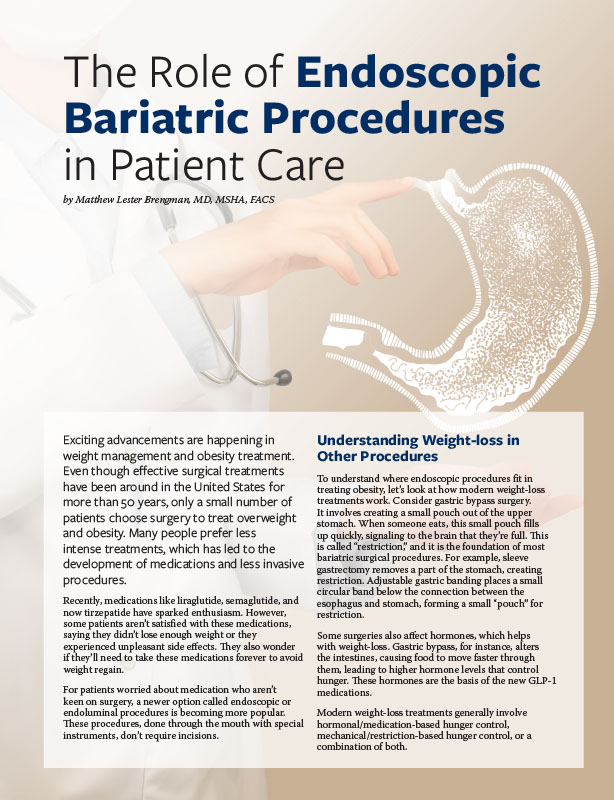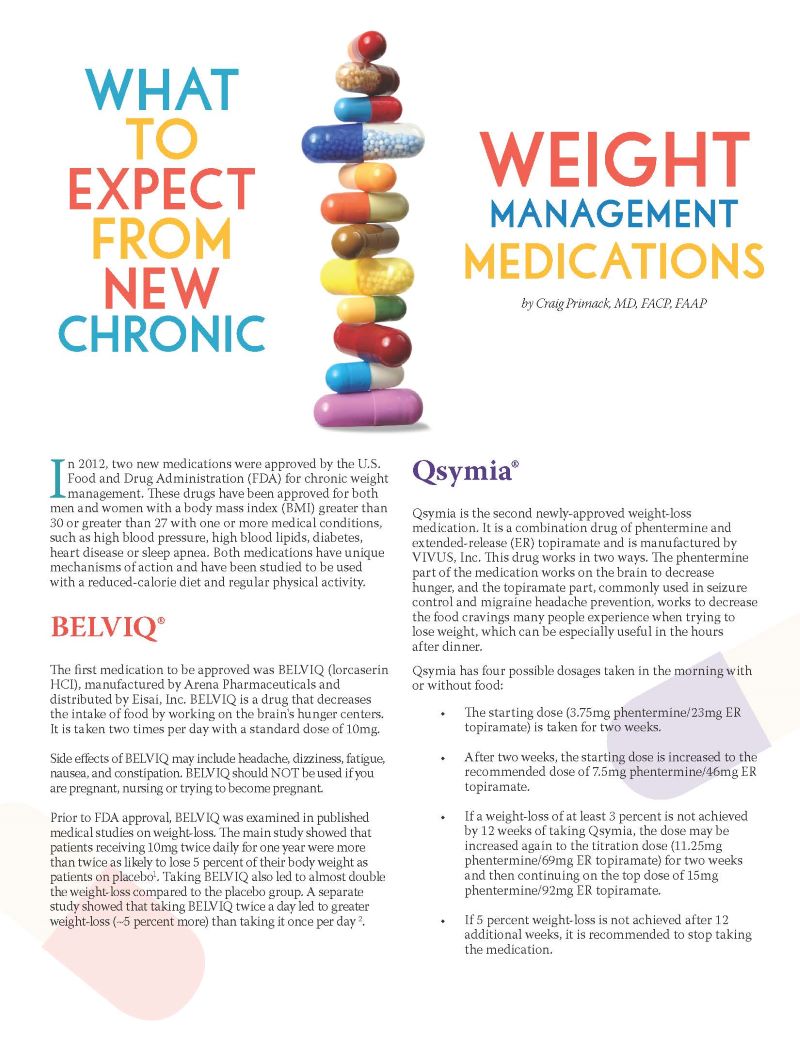The Role of Endoscopic Bariatric Procedures in Patient Care


by Matthew Lester Brengman, MD, MSHA, FACS
Spring 2024
Exciting advancements are happening in weight management and obesity treatment. Even though effective surgical treatments have been around in the United States for more than 50 years, only a small number of patients choose surgery to treat overweight and obesity. Many people prefer less intense treatments, which has led to the development of medications and less invasive procedures.
Recently, medications like liraglutide, semaglutide, and now tirzepatide have sparked enthusiasm. However, some patients aren’t satisfied with these medications, saying they didn’t lose enough weight or they experienced unpleasant side effects. They also wonder if they’ll need to take these medications forever to avoid weight regain.
For patients worried about medication who aren’t keen on surgery, a newer option called endoscopic or endoluminal procedures is becoming more popular. These procedures, done through the mouth with special instruments, don’t require incisions.
Understanding Weight-loss in Other Procedures
To understand where endoscopic procedures fit in treating obesity, let’s look at how modern weight-loss treatments work. Consider gastric bypass surgery. It involves creating a small pouch out of the upper stomach. When someone eats, this small pouch fills up quickly, signaling to the brain that they’re full. This is called “restriction,” and it is the foundation of most bariatric surgical procedures. For example, sleeve gastrectomy removes a part of the stomach, creating restriction. Adjustable gastric banding places a small circular band below the connection between the esophagus and stomach, forming a small “pouch” for restriction.
Some surgeries also affect hormones, which helps with weight loss. Gastric bypass, for instance, alters the intestines, causing food to move faster through them, leading to higher hormone levels that control hunger. These hormones are the basis of the new GLP-1 medications.
Modern weight-loss treatments generally involve hormonal/medication-based hunger control, mechanical/restriction-based hunger control, or a combination of both.
Endoscopic Procedures
Now, let’s talk about endoscopic weight-loss interventions. There are two common types: intragastric balloons and endoscopic sleeve gastroplasty.
Intragastric Balloons:
There are three FDA-approved intragastric balloons. These are devices, inflated with either gas or liquid, that are swallowed or placed using an endoscope. They stay in the stomach for up to eight months, taking up space and slowing down food emptying, leading to early fullness and prolonged hunger control (restriction). When the balloon is ready to be removed, it is done in a quick procedure using the endoscope.
The intragastric balloon is very safe. Although most patients experience some symptoms for the first few days after placement, overall, they tolerate the balloon well. On average, patients lose about 10% of their total body weight during their balloon therapy. Most obesity management programs include intragastric balloons in a thorough follow-up plan involving frequent visits with dietitians and obesity medicine physicians.
The amount of weight lost with the balloon can vary, which makes sense because stomach sizes vary among individuals. There is now an FDA-approved adjustable gastric balloon, which seems to lead to greater weight-loss compared to single-size balloons.
Many patients see the temporary nature of the intragastric balloon as an advantage. It provides them with the push they need to manage their weight without permanently altering their stomach. However, long-term weight outcomes with the balloon are mixed. Like when stopping medications, removing the balloon can lead to the return of obesity for some patients.
Endoscopic Sleeve Gastroplasty:
The other FDA-approved endoscopic procedure for obesity treatment is endoscopic sleeve gastroplasty, or ESG. This incision-less procedure is also done through the mouth with a special sewing device on the endoscope. With this device, the doctor can take thick bites of the stomach from the inside. Taking multiple bites and tightening the suture shrinks the stomach size by up to 90%.
Inside, the stomach can look like a surgical sleeve gastrectomy. This “restriction” is done without incisions or removing part of the stomach. Large studies have shown ESG to be much safer than gastric sleeve surgery. After a few days of getting used to eating and drinking differently, the patient can go back to their usual activities. Most centers do ESG as a same-day procedure, with patients going home a couple of hours after.
ESG patients can expect to lose 15-20% of their total body weight. This dramatic weight loss seems to last for at least two years and five years, as shown by studies. Weight loss happens because patients feel full sooner and can control hunger longer after eating a small amount of food. Studies haven’t shown a significant hormonal change after ESG. Some people see this as a downside, while others see it as a chance to use medications for a bigger effect on obesity without surgery. Using medications and endoscopic procedures together for obesity treatment is new but promising.
How do these endoscopic procedures fit into treating obesity? Choosing the right treatment is complex. It’s about balancing patients’ medical goals with the risks and side effects of treatment. Treating obesity is no different. We look at how severe someone’s obesity is, often measured by body mass index (BMI) and other health issues linked to obesity. We balance these with how intense the treatment is and possible complications and side effects.
When I talk to patients about this, we start with how severe their obesity and related conditions are. Endoscopic procedures are FDA-approved for patients with a BMI of 30-50. These procedures usually result in losing 10-20% of total body weight. For patients with a BMI between 30 and 40, losing 20% of their total body weight can significantly improve obesity-related medical issues. With the low impact of the initial procedure and very few complications and side effects, endoscopic procedures are an important, safe and lasting tool for treating obesity in this group.
About the Author:
Matthew Brengman, MD, MSHA, FACS, is a board-certified general and bariatric surgeon practicing in Richmond, Virginia.
by Robert Kushner, MD Spring 2024 Disclaimer: Before considering Zepbound®, consult with your healthcare provider. In November…
Read Articleby Craig Primack, MD, FACP, FAAP Fall 2013 Please Note: As of February 2020, the Food and…
Read Article







